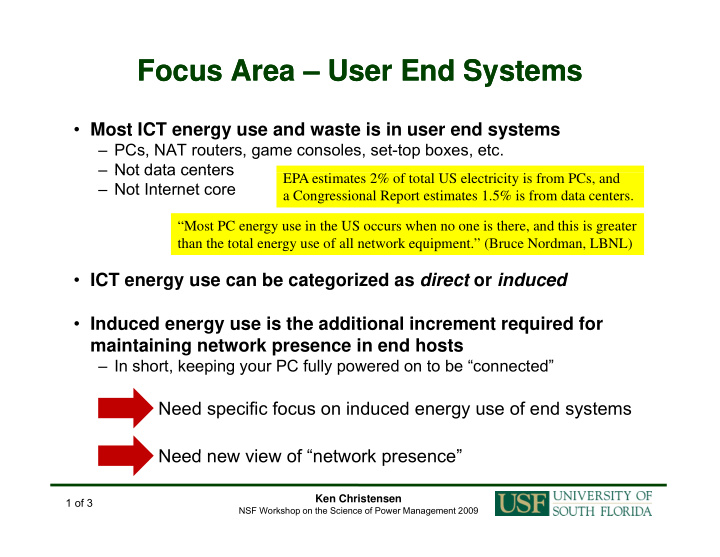



Focus Area Focus Area – – User End Systems User End Systems • Most ICT energy use and waste is in user end systems – PCs, NAT routers, game consoles, set-top boxes, etc. – Not data centers Not data centers EPA estimates 2% of total US electricity is from PCs, and i f l l i i i f d – Not Internet core a Congressional Report estimates 1.5% is from data centers. “Most PC energy use in the US occurs when no one is there, and this is greater than the total energy use of all network equipment ” (Bruce Nordman LBNL) than the total energy use of all network equipment. (Bruce Nordman, LBNL) • ICT energy use can be categorized as direct or induced • Induced energy use is the additional increment required for maintaining network presence in end hosts – In short, keeping your PC fully powered on to be “connected” Need specific focus on induced energy use of end systems Need new view of “network presence” Need new view of network presence” Ken Christensen 1 of 3 NSF Workshop on the Science of Power Management 2009
Addressing Network Presence Addressing Network Presence • Industry offers point solutions to enable sleep – e.g., Verdiem • Research projects are underway • Research projects are underway – e.g., Somniloquy e g Somniloquy • Standards addressing idea of a network connectivity proxy ‒ Ecma TC32-TG21 – Proxying support for sleep modes c a C3 G o y g suppo o s eep odes • Resulting from work from a previously funded NSF grant and with Bruce Nordman at LBNL. Adopted in EPA Energy Star specification. • New view of network connectivity is needed • New view of network connectivity is needed on off To support selective connectivity need to explore [1]: Connected Not connected • Assistants • Exposing selective connectivity • Evolving soft state T diti Traditional l Delay D l sleep • Host-based control Internet Tolerant • Application primitives Networks Selectively connected • Security (as chosen by the host) [1] M. Allman , K. Christensen, B. Nordman, and V. Paxson, "Enabling an Energy-Efficient Future Internet through Selectively Connected End Systems,“ Sixth Workshop on Hot Topics in Networks (HotNets-VI) , November 2007. Ken Christensen 2 of 3 NSF Workshop on the Science of Power Management 2009
Considering the Science Considering the Science • Science evolves as Describe – Explain – Predict • To describe we need to • To describe we need to… – Expose power state (especially of sleeping hosts) • Also useful for energy use audits, redirection of requests, etc. – Categorize energy use (by user profile, activity, time-of-day, etc.) • To explain we need to… – Understand why hosts are powered-on for network presence • Protocols applications etc that drive this • Protocols, applications, etc. that drive this – Understand how protocols and applications can be designed for sleep • To predict we need to… p – Develop new tools to predict performance versus energy use trade-offs Goal must be energy-proportional computing at all levels ‒ Not just in the data center Ken Christensen 3 of 3 NSF Workshop on the Science of Power Management 2009
Recommend
More recommend